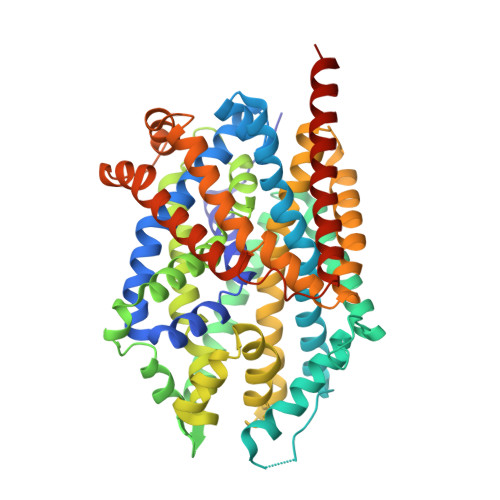A conserved leucine occupies the empty substrate site of LeuT in the Na(+)-free return state.
Malinauskaite, L., Said, S., Sahin, C., Grouleff, J., Shahsavar, A., Bjerregaard, H., Noer, P., Severinsen, K., Boesen, T., Schitt, B., Sinning, S., Nissen, P.(2016) Nat Commun 7: 11673-11673
- PubMed: 27221344
- DOI: https://doi.org/10.1038/ncomms11673
- Primary Citation of Related Structures:
5JAE, 5JAF, 5JAG - PubMed Abstract:
Bacterial members of the neurotransmitter:sodium symporter (NSS) family perform Na(+)-dependent amino-acid uptake and extrude H(+) in return. Previous NSS structures represent intermediates of Na(+)/substrate binding or intracellular release, but not the inward-to-outward return transition. Here we report crystal structures of Aquifex aeolicus LeuT in an outward-oriented, Na(+)- and substrate-free state likely to be H(+)-occluded. We find a remarkable rotation of the conserved Leu25 into the empty substrate-binding pocket and rearrangements of the empty Na(+) sites. Mutational studies of the equivalent Leu99 in the human serotonin transporter show a critical role of this residue on the transport rate. Molecular dynamics simulations show that extracellular Na(+) is blocked unless Leu25 is rotated out of the substrate-binding pocket. We propose that Leu25 facilitates the inward-to-outward transition by compensating a Na(+)- and substrate-free state and acts as the gatekeeper for Na(+) binding that prevents leak in inward-outward return transitions.
Organizational Affiliation:
Danish Research Institute of Translational Neuroscience-DANDRITE, Nordic-EMBL Partnership for Molecular Medicine, Department of Molecular Biology and Genetics, Aarhus University, Gustav Wieds Vej 10C, Aarhus C DK-8000, Denmark.















